Engine, General
General inspection
Make it a habit to give the engine and engine compartment a visual inspection before starting the engine and after operation once the engine has stopped. This will help you to discover quickly if anything abnormal has happened, or is about to happen. Look especially carefully at oil, fuel and coolant leakage, loose bolts, worn or poorly tensioned drive belts, loose connections, damaged hoses and electrical cables. This inspection only takes a few minutes and can prevent serious malfunctions and expensive repairs.
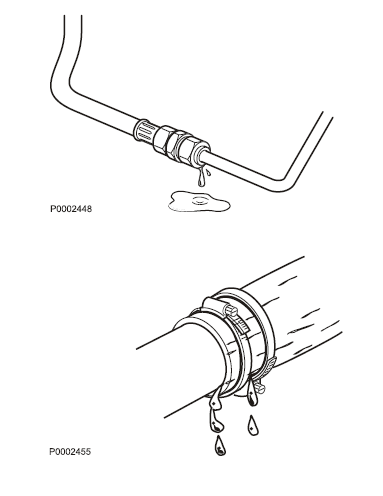
WARNING!
Accumulations of fuel, oil and grease on the engine or in the engine room is a fire hazard and must be removed immediately they are detected.
WARNING!
If an oil, fuel or coolant leak is detected, the cause must be investigated and the fault rectified before the Volvo engine is started.
IMPORTANT!
Remember the following when washing with a power washer: Never aim the water jet at radiators, charge air cooler, seals, rubber hoses or electrical components.
Air Filter, Check and Change
The engine is equipped with electronic air filter indication. The control unit provides an output signal which is announced as a warning on the instrument panel. The warning indicates a pressure drop in the air filter, which must then be checked and possibly changed.
• Scrap the old filter. No cleaning or re-use is permissible
• In continuous operation, the filter should be checked every 8 hours. For operations in extremely dirty environments such as coal mines and rock crushing mills, special air filters must be used.
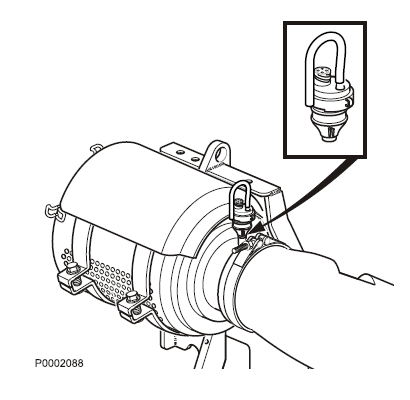
Charge Air Pipe, Leakage Check
Inspect the condition of the charge air hoses, hose union s and clamps for cracks and other damage. Change as necessary.
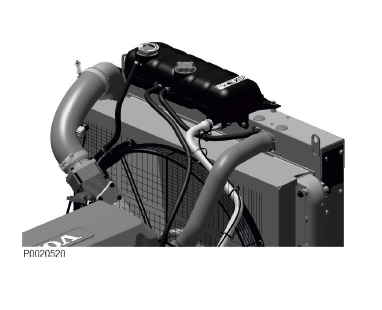
IMPORTANT!
Clamps must be tightened using a torque wrench to 9 ±2 Nm (6.6 ±1.5 lbf.ft.).
Drive Belt and Alternator Belt,
Inspection
Inspections must be carried out after operations, while the belts are hot. You should be able to depress the alternator belt and the drive belt about 3-4 mm between the pulleys.
The alternator belts and drive belts have automatic belt tensioners and do not need to be adjusted. Check the condition of the drive belts. Replace as necessary; refer to Alternator Belt, Change page 51 and Drive Belt, Change page 50.
Drive Belt, Change
1 Disconnect the main switch(es) and check that the engine is not connected to system voltage.
2 Remove the fan guard and fan ring round the cooling fan.
3 Remove the belt guard.
4 Place a 1/2" square wrench in the belt tensioner (1). Lift the wrench and remove the drive belt.
5 Thread the drive belt round the fan and remove it.
6 Check that the pulleys are clean and undamaged.
7 Thread the new drive belt over the fan.
8 Lift the 1/2" wrench and install the new drive belt.
9 Install the belt guards.
10 Install the fan guard and fan ring round the cooling fan.
11 Start the engine and perform a function check.
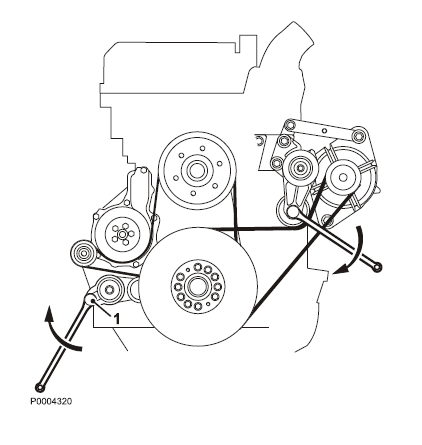
Alternator Belt, Change
IMPORTANT!
Always replace a drive belt that seems worn or is cracked.
1 Disconnect the main switch(es) and check that the engine is not connected to system voltage.
2 Remove the fan guard and fan ring round the cooling fan.
3 Remove the belt guard.
4 Place a 1/2" square wrench in the belt tensioner (1). Lift the wrench up and lift the water pump drive belt off.
5 Place a 1/2" square wrench in the belt tensioner (2). Press the wrench down and remove the alternator belt.
6 Check that the pulleys are clean and undamaged.
7 Press the 1/2" wrench in the belt tensioner (2) down and install the new alternator drive belt.
8 Lift the 1/2" wrench in the belt tensioner (1) and reinstall the water pump drive belt.
9 Install the belt guards.
10 Install the fan guard and fan ring round the cooling fan.
11 Start the engine and perform a function check.
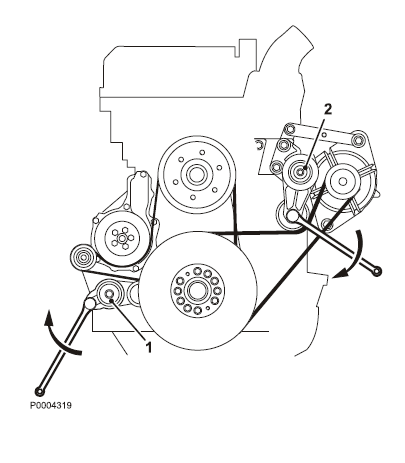
Lubrication System
Oil change intervals may vary according to the lubrication oil grade, fuel sulfur content and running conditions.
Refer to Technical data, Lubrication system.
The oil change interval may under certain conditions be increased. To see if the engine complies Volvo Penta oil analysis needs to be performed. Contact your Volvo Penta dealer for further information.
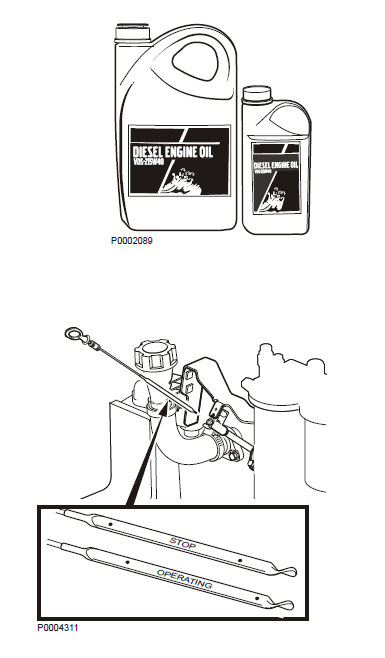
NOTICE! Oil change intervals must never exceed a period of 12 months.
Oil level, checking and topping up
The oil level must be inside the marked area on the dipstick and must be checked daily before the first start.
• Top up with oil via the filler opening, please refer to Maintenance page 47. Check that the correct level has been achieved. If the engine is stationary, wait for a few minutes to allow the oil to run down into the oil pan.
• The oil level can be read both when the engine is stationary (the STOP side of the dipstick) and with the engine running (the OPERATING side of the dipstick). Do not fill up above the maximum oillevel. Only use a recommended grade of oil, please refer to Technical Data page 69.
• The oil level sensor only measures the oil level at the time when the ignition is turned on. In other words, not continually during operation.
Engine Oil, Change
WARNING!
Hot oil and hot surfaces can cause burns. Oil changes must be done when the engine is hot.
1 Connect the drain hose to the oil drain pump and check that no leakage can occur.
2 Pump the oil out (or remove the bottom drain plug and drain the oil). Collect all the old oil and old filters, and hand them to a re-cycling station for destruction.
3 Remove the drain hose (or install the bottom drain plug).
4 Fill with engine oil. For change volume, please refer to Technical Data page 69.
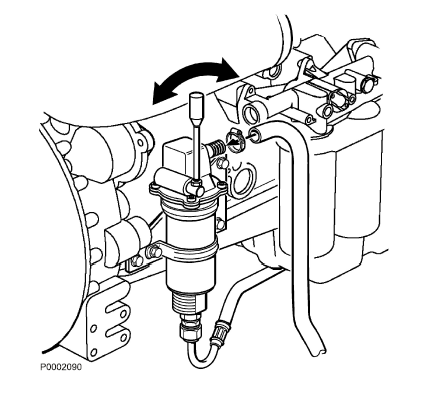
Oil Filter/By-pass Filter, Change
WARNING!
Hot oil and hot surfaces can cause burns.
1 Clean the oil filter bracket (2).
2 Remove all oil filters with a suitable oil filter extractor (1).
3 Clean the mating surface of the oil filter bracket. Make sure that no remnants of old oil seal are left behind. Carefully clean round the inside of the protective rim (2) on the oil filter bracket.
4 Put a thin layer of engine oil on the seal rings of the new oil filters.
5 Install the new oil filters. Tighten the two full-flow filters (on the right of the illustration) 1/2–3/4 of a turn after they bottom. Tighten the bypass filter 3/4– 1 turn after it bottoms.
6 Top up with engine oil, start the engine and let it run for 20-30 seconds.
7 Stop the engine, check the oil level and top up as required.
8 Check the sealing round the oil filters.
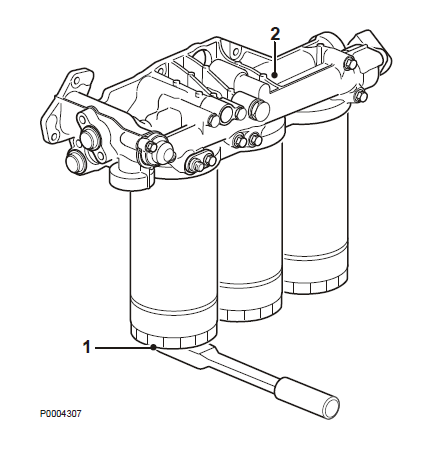
Fuel System
WARNING!
Fire hazard. When carrying out work on the fuel system make sure the engine is cold. A fuel spill onto a hot surface or an electrical component can cause a fire. Store fuel soaked rags so that they cannot cause fire.
IMPORTANT! Only use the grades of fuel recommended in the fuel specification below, refer to Technical Data page 71. Always observe the greatest cleanliness during re-fueling and work on the fuel system.
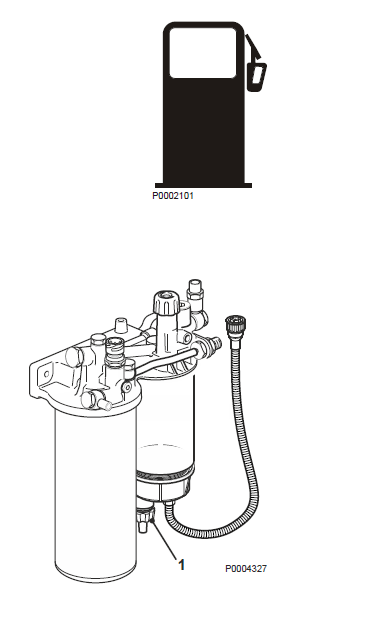
IMPORTANT!
All work on the engine injection system must be done by an authorized workshop.
Draining condensate, fuel system
1 Put a collection vessel under the fuel filter to collect the condensate and fuel.
2 Open the drain nipple (1) in the base of the fuel prefilter.
3 Tighten the drain tap (1) when fuel without water starts to run out.
Engine Fuel Filter Replacement
The fuel filter shall be replaced while the engine is cold.
WARNING!
Fire hazard. When carrying out work on the fuel system make sure the engine is cold. A fuel spill onto a hot surface or an electrical component can cause a fire. Store fuel soaked rags so that they cannot cause fire. Do not fill the new fuel filter with fuel before assembly. There is a risk that contamination could get into the system and cause malfunctions or damage.
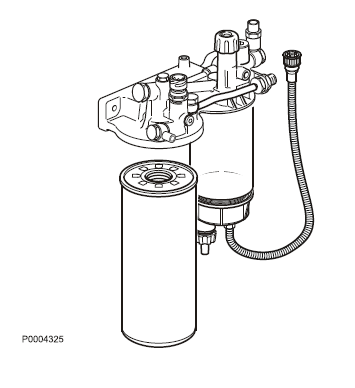
1 Clean round the fuel filter.
2 Remove the filter with a suitable filter remover. Collect any spilled fuel in a collection vessel.
3 Clean the filter mating surface on the filter bracket.
4 Lubricate the seal with diesel fuel and install the new fuel filter. Tighten the fuel filter in accordance with the instructions on the fuel filter.
5 Where necessary, bleed the fuel system; refer to Bleeding the Fuel System page 55.
6 If a water trap is installed, change the filter in it at the same time as the fuel filter, and clean the water trap in the plastic bowl under the filter with a soft rag.
Fuel Pre-filter, Change
1 Undo the cable from the water trap sensor.
2 Remove the water trap filter from the filter bracket. Collect any spilled fuel in a collection vessel.
3 Remove the lower part of the water trap from the filter.
4 Clean the lower part of the water trap with a soft rag. Check that the drain hole in the lower part is not blocked.
5 Install a new seal on the lower part and lubricate the seal with diesel fuel. Re-install the lower part of the filter.
6 Lubricate the seal with diesel fuel. Screw the filter onto the filter bracket by hand until the rubber seal just touches the mating surface. Then tighten a further half turn, no more.
7 Connect the cable to the water trap sensor.
8 Where necessary, purge the fuel system; refer to Bleeding the Fuel System page 55.
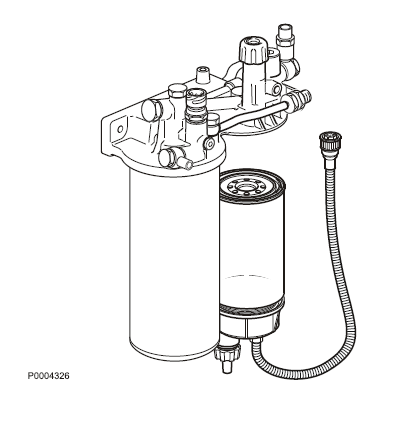
Bleeding the Fuel System
The system does not need to be bled unless it has been run completely dry. Purging is then done with the hand pump on the fuel filter bracket.
For More Volvo Engine workshop information, please visit:
Volvo Diesel Engine Fault Handling
Instructions to Check Volvo Engine Before Starting
Copyright © Guangxi Dingbo Generator Set Manufacturing Co., Ltd. All Rights Reserved | Sitemap
Update cookies preferences